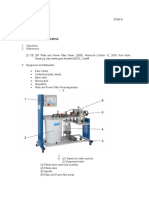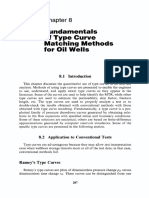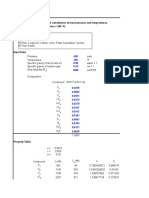Assignment 1
Uploaded by
Dexter TanabeAssignment 1
Uploaded by
Dexter TanabeASSIGNMENT ONE: To be submitted on Tuesday 08 – Aug - 2020
NB: Some of the data in the following questions are given based on your matric number. LL is the last
two digits and FF is the first two digits of your matric number.
1. Given a reservoir with the following properties:
𝑃𝑖 = 3500 + 100(𝐹𝐹/𝐿𝐿)𝑝𝑠𝑖 𝑟𝑤 = 0.25 𝑓𝑡
𝑞 = 250 𝑆𝑇𝐵/𝐷 𝑘 = 25 + 10(𝐹𝐹/𝐿𝐿)𝑚𝑑
𝑐𝑡 = 20 × 10−6 𝑝𝑠𝑖 −1 𝑠=5
𝜇 = 1𝑐𝑝 ℎ = 60 𝑓𝑡
𝑟𝑒 = 0.25 𝑓𝑡 𝝓 = 20%
𝐵 = 1.25 𝑅𝐵/𝑆𝑇𝐵
a. Calculate the time at which the Ei function solution first becomes valid.
b. Calculate the time after which the Ei function solution is no longer valid.
c. Calculate and plot the pressure as a function of position on a semilog graph paper at
t=100 hours using the Ei function solution (or its logarithmic approximation) for r = 0.25 ft, r =
2 ft, r = 10 ft, r = 50 ft, r = 100 ft, r = 500 ft, r = 1000 ft, r = 2000ft, r = 3000 ft. Use the log
approximation only if it is valid.
d. Calculate the additional pressure drop due to the skin factor.
2. High Hopes Operating, Inc. has just completed the discovery well in the Yellow Sandstone formation.
There are three phases present in the formation, but oil is the only mobile phase. The following formation,
well, and fluid properties apply:
𝑑𝑒𝑝𝑡ℎ = 4356 + 10(𝐹𝐹/𝐿𝐿) 𝑓𝑡 ℎ = 22 𝑓𝑡
𝑃𝑖 = 950 𝑝𝑠𝑖𝑎 𝑟𝑤 = 9 𝑖𝑛.
𝜙 = 12% 𝑘 = 35.5 + 10(𝐹𝐹/𝐿𝐿)𝑚𝑑
𝛾0 = 32.5 ° 𝐴𝑃𝐼 𝛾𝑔 = 0.893
𝑆𝑤 = 18% 𝐶𝑤 = 2.6 𝑋 10−5 𝑝𝑠𝑖 −1
𝑆𝑔 = 16% 𝐶𝑔 = 1.188 𝑋 10−3 𝑝𝑠𝑖 −1
𝑆0 = 66% 𝐶0 = 4.23 𝑋 10−4 𝑝𝑠𝑖 −1
𝜇0 = 1.17 𝑐𝑝 𝐶𝑓 = 5 X 10−06 𝑝𝑠𝑖 −1
𝑅𝑆0 = 226 𝑠𝑐𝑓/𝑆𝑇𝐵 𝐵0 = 1.146 𝑅𝐵/𝑆𝑇𝐵
𝑠= 0 𝑞 = 165 + 10(𝐹𝐹/𝐿𝐿)𝑆𝑇𝐵/𝐷
Calculate:
a. The total compressibility Ct.
b. The time at which the Ei function solution first becomes valid.
c. The pressure at the wellbore after the well has been producing for 1 hour.
d. The pressure 10 ft from the center of the wellbore after 1 hour.
e. The pressure 100 ft from the center of the wellbore after 1 hour.
3. A drawdown test is run on an oil well at a series of three different rates, with each flow period lasting
3 hours. Given the following formation and fluid properties, estimate formation permeability and skin
factor from the test data using the multirate analysis method: 𝑞1 = 15 𝑆𝑇𝐵/𝐷; 𝑞2 = 30 𝑆𝑇𝐵/𝐷; 𝑞3 =
45 𝑆𝑇𝐵/𝐷; 𝑝𝑖 = 5883.16 + 5(𝐹𝐹/𝐿𝐿)𝑝𝑠𝑖; ℎ = 13 𝑓𝑡; 𝜙 = 17.7 + 5(𝐹𝐹/𝐿𝐿)%; 𝑟𝑤 = 0.42 𝑓𝑡; 𝐵 =
1.231 𝑅𝐵/𝑆𝑇𝐵; 𝐶𝑡 = 9.79 𝑋 10−06 𝑝𝑠𝑖 −1 ; 𝑎𝑛𝑑 𝜇 = 3.371 𝑐𝑝.
Time Pressure Time Pressure Time Pressure
(hours) (Psi) (hours) (Psi) (hours) (Psi)
0.5 5349.68 3.5 4778.26 6.5 4195.34
1 5335.65 4 4761.74 7 4177.45
1.5 5327.76 4.5 4751.66 7.5 4166.1
2 5322.27 5 4744.21 8 4157.46
2.5 5318.05 5.5 4738.22 8.5 4150.36
3 5314.62 6 4733.19 9 4144.26
4. Estimate formation permeability and skin factor from the buildup test data, given the following
formation and fluid properties: ℎ = 62 + 5(𝐹𝐹/𝐿𝐿)𝑓𝑡; 𝜙 = 21.5 %; 𝑟𝑤 = 0.26 𝑓𝑡; 𝐵 = 1.163 𝑅𝐵/
𝑆𝑇𝐵; 𝐶𝑡 = 8.38𝑥10−06 ; 𝑎𝑛𝑑 𝜇 = 2.19 𝑐𝑝. Note that the short final flow period makes use of the Horner
pseudo producing time approximation inappropriate. The well was producing at a rate of 180 STB/D and
90 STB/D for 144 hrs and 6 hrs, respectively before it was shut in.
Time Pressure Time Pressure Time Pressure
(hours) (Psi) (hours) (Psi) (hours) (Psi)
0 5048 0.213 5476.1 2.69 5519.1
0.005 5167.4 0.271 5480.2 3.37 5523.3
0.011 5265.2 0.344 5484.1 4.22 5527.7
0.019 5339 0.435 5488 5.27 5532.2
0.029 5390 0.548 5491.8 6.6 5536.8
0.041 5422.4 0.691 5495.6 8.25 5541.5
0.056 5442 0.868 5499.3 10.32 5546.3
0.075 5453.8 1.09 5503.2 12.9 5551.2
0.099 5461.5 1.368 5507 16.14 5556.2
0.129 5467.1 1.715 5511 20.17 5561.1
0.166 5471.8 2.15 5515 24 5564.9
You might also like
- Send A SINGLE .PDF File To:: Advanced Well Testing ExamNo ratings yetSend A SINGLE .PDF File To:: Advanced Well Testing Exam10 pages
- Exercises On Fluid Flow in HC ReservoirsNo ratings yetExercises On Fluid Flow in HC Reservoirs3 pages
- Interpretation of Multirate Test by Tue Pressure Derivative Oil Reservoirs100% (1)Interpretation of Multirate Test by Tue Pressure Derivative Oil Reservoirs12 pages
- Introduction To Well Testing 1650060017No ratings yetIntroduction To Well Testing 165006001751 pages
- Pansystem Analysis of Drawdown and Build-Up TestNo ratings yetPansystem Analysis of Drawdown and Build-Up Test11 pages
- ρ = ρ = constant: One-Dimensional, One-Phase Reservoir SimulationNo ratings yetρ = ρ = constant: One-Dimensional, One-Phase Reservoir Simulation10 pages
- HW - 3 - PEQ 202 - Dr. Adel Salem - Fall 2020 - AnswerNo ratings yetHW - 3 - PEQ 202 - Dr. Adel Salem - Fall 2020 - Answer7 pages
- Lab 3 Porosity Determination Using Helium Porosimeter MethodNo ratings yetLab 3 Porosity Determination Using Helium Porosimeter Method6 pages
- Approximating Well To Fault Distance From Pressure Build-Up TestsNo ratings yetApproximating Well To Fault Distance From Pressure Build-Up Tests7 pages
- Chapter 8 - Fundamentals of Type Curve Matching Methods For Oil WellsNo ratings yetChapter 8 - Fundamentals of Type Curve Matching Methods For Oil Wells52 pages
- School of Energy, Geoscience, Infrastructure & Society Institute of Geoenergy Engineering G11Wt Reservoir Engineering - Well Test Analysis100% (1)School of Energy, Geoscience, Infrastructure & Society Institute of Geoenergy Engineering G11Wt Reservoir Engineering - Well Test Analysis15 pages
- Well Testing Methods For Naturally Fractured Reservoirs: KM KFNo ratings yetWell Testing Methods For Naturally Fractured Reservoirs: KM KF33 pages
- Horner Analysis Method For Pressure Buildup Test: Pws Vs Time FunctionNo ratings yetHorner Analysis Method For Pressure Buildup Test: Pws Vs Time Function4 pages
- Applications of Differential Equations in Petroleum EngineeringNo ratings yetApplications of Differential Equations in Petroleum Engineering5 pages
- Apects of Porosity Units and Zonation in Carbonate ReservoirNo ratings yetApects of Porosity Units and Zonation in Carbonate Reservoir39 pages
- Part 11 Average Pressure Computations MBHNo ratings yetPart 11 Average Pressure Computations MBH5 pages
- Formation Testing: Supercharge, Pressure Testing, and Contamination ModelsFrom EverandFormation Testing: Supercharge, Pressure Testing, and Contamination ModelsNo ratings yet
- Section - A: Department of Petroleum and Mining Engineering Chittagong University Engineering TechnologyNo ratings yetSection - A: Department of Petroleum and Mining Engineering Chittagong University Engineering Technology20 pages
- Student Solutions Manual to Accompany Loss Models: From Data to Decisions, Fourth EditionFrom EverandStudent Solutions Manual to Accompany Loss Models: From Data to Decisions, Fourth Edition4/5 (1)
- 54593+89+BIF BAF+Chemical+Free+Iron+Filter+ManualNo ratings yet54593+89+BIF BAF+Chemical+Free+Iron+Filter+Manual40 pages
- Grease Lubrication Mechanisms in Rolling Bearing Systems: Piet M. LugtNo ratings yetGrease Lubrication Mechanisms in Rolling Bearing Systems: Piet M. Lugt4 pages
- Chapter - 1 Preamble, Water Source & Availability and Selection of Water Intake LocationNo ratings yetChapter - 1 Preamble, Water Source & Availability and Selection of Water Intake Location157 pages
- Instant Download (Ebook) Fluid Mechanics: A Problem-Solving Approach by Naseem Uddin ISBN 1032324538 PDF All Chapters100% (8)Instant Download (Ebook) Fluid Mechanics: A Problem-Solving Approach by Naseem Uddin ISBN 1032324538 PDF All Chapters81 pages
- EM 1110-1-3500 31 Jan 95: B. Chemical Grouting. Chemical Grouting Is TheNo ratings yetEM 1110-1-3500 31 Jan 95: B. Chemical Grouting. Chemical Grouting Is The3 pages
- Bundschuh, Jochen - Numerical Modeling of Isothermal Groundwater and Geothermal Systems - Mass, Solute and Heat Transport (2007, Taylor & Francis)No ratings yetBundschuh, Jochen - Numerical Modeling of Isothermal Groundwater and Geothermal Systems - Mass, Solute and Heat Transport (2007, Taylor & Francis)501 pages
- High Temperature Compact Heat Exchangers: Performance of Advanced Metallic Recuperators For Power PlantsNo ratings yetHigh Temperature Compact Heat Exchangers: Performance of Advanced Metallic Recuperators For Power Plants9 pages
- Bearing Root Cause Failure Analysis - Per Arnold - BRCE2016 PDF100% (1)Bearing Root Cause Failure Analysis - Per Arnold - BRCE2016 PDF85 pages































































































